2023 Nissan FRONTIER Instrument panel, gauges, Warning lights, and indicator lights
Instrument panel
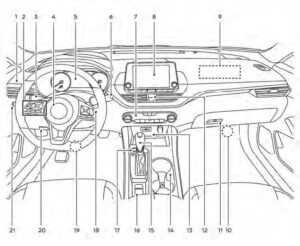
- Vents
- Headlight/fog lights (if so equipped)/turn signal switch
- Bluetooth® Hands-Free Phone System
Audio system controls - Driver supplemental air bag. Horn
- Meters and gauges
Warning and indicator lights. Vehicle information display - Cruise control switches (if so equipped)
Intelligent cruise control (ICC) switches (if so equipped) - Wiper and washer switch
- Climate controls. The outside mirror defroster switch
(if so equipped) - Storage
- . Audio system
- Front passenger airbag status light
Hazard warning flasher switch. Idling stop OFF switch - Front passenger supplemental airbag
- Front passenger supplemental knee airbag
- Glove box
- Power outlet
- Storage
- Heated seats (if so equipped)
- USB connection port
AUX input (if so equipped) - Shift lever
- Heated steering wheel switch (if so equipped)
Parking Aids system switch (if so equipped) - 4WD shift switch (if so equipped)
- Push-button ignition switch
- Driver supplemental knee airbag
- Tilt steering wheel control
- Parking brake
- Hood release
- Cargo lamp switch, Electronic locking rear differential
(E-Lock) system switch (if so equipped)
Hill descent control switch (if so equipped)
Power inverter switch (if so equipped)
Tow mode switch (if so equipped)
Warning systems switch (if so equipped)
Vehicle Dynamic Control (VDC) OFF switch
2023 Nissan Frontier Specs, Price, Features and Mileage
METERS AND GAUGES
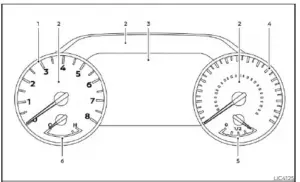
- Tachometer
- Warning and indicator lights
- Vehicle information display Odometer
Outside temperature display - Speedometer
- Fuel gauge
- Engine coolant temperature gauge
SPEEDOMETER AND ODOMETER
This vehicle is equipped with a speedometer and odometer. The speedometer is located on the right side of the meter cluster. The odometer is located in the vehicle information display to the left of the speedometer and can be accessed with the vehicle in the ON position.+
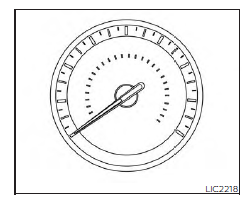
Speedometer
The speedometer indicates the vehicle’s speed.
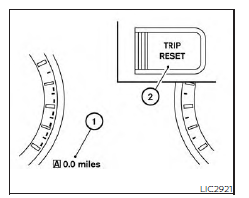
Odometer/Twin trip odometer
The odometer and the twin trip odometer 1O are displayed in the vehicle information display when the ignition switch is placed in the ON position.
The odometer records the total distance the vehicle has been driven.
The twin trip odometer records the distance of individual trips.
Changing the display
Push the TRIP RESET switch 2O on the left side of the instrument panel to change the display as follows:
ODO → Trip → Trip
Resetting the trip odometer
Pushing the TRIP RESET switch 2O for about 2 seconds resets the currently displayed trip odometer to zero.

TACHOMETER
The tachometer indicates engine speed in revolutions per minute (rpm). Do not rev the engine into the red zone 1O.
CAUTION
When engine speed approaches the red zone, reduce engine speed. Operating the engine in the red zone may cause serious engine damage.
ENGINE COOLANT TEMPERATURE GAUGE
The gauge indicates the engine coolant temperature. The engine coolant temperature is within the normal range 1O when the gauge needle points within the zone shown in the illustration.
The engine coolant temperature varies with the outside air temperature and driving conditions.
CAUTION
If the gauge indicates coolant temperature near the hot (H) end of the normal range, reduce vehicle speed to decrease temperature. If the gauge is over the normal range, stop the vehicle as soon as safely possible. If the engine is overheated, continued operation of the vehicle may seriously damage the engine. For additional information, see “If your vehicle overheats” for immediate action required.

FUEL GAUGE
- The gauge indicates the approximate fuel level in the tank.
- The gauge may move slightly during braking, turning, acceleration, or going up or down hills.
- The gauge needle returns to 0 (Empty) after the ignition switch is placed in the OFF position.
- The low fuel warning light comes on when the amount of fuel in the tank is getting low.
Refill the fuel tank before the gauge registers 0 (Empty).
The indicates that the fuel-filler door is located on the driver’s side of the vehicle.
CAUTION
- If the vehicle runs out of fuel, the Malfunction Indicator Light (MIL) may come on. Refuel as soon as possible. After a few driving trips. the light should turn off. If the light remains on after a few driving trips, have the vehicle inspected. It is recommended that you visit a NISSAN dealer for this service.
- For additional information, see Malfunction Indicator Light (MIL)â.
DISTANCE TO EMPTY (DTE)
Displays the estimated distance the vehicle can be driven before refueling. The value is calculated based on recent fuel economy, the amount of fuel remaining in the fuel tank, and the actual fuel consumption.
Changes in driving patterns or conditions can cause the DTE value to vary. As a result, the value displayed may differ from the ac-tual distance that can be driven.
DTE display will change to “—” when the fuel level in the tank is getting low, prior to the fuel gauge reaching 0 (Empty).
NOTE:
- The DTE value after refill is estimated based on recent fuel economy and amount of fuel added.
- If a small amount of fuel is added, or the ignition is on during refueling, the display may not be updated.
- Conditions that affect the fuel economy will also affect the estimated DTE value (city/highway driving, idle time, remote start time, terrain, seasonal weather, added vehicle weight, added deflectors, roof racks, etc.).
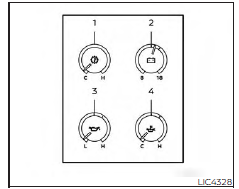
AUXILIARY GAUGES (if so equipped)
- Automatic Transmission fluid temperature gauge
- Voltmeter
- Engine oil pressure gauge
- Engine oil temperature gauge
Automatic Transmission fluid temperature gauge
This gauge indicates the temperature of the automatic transmission fluid.
CAUTION
- This gauge is not designed to indicate low automatic transmission fluid level. Use the dipstick to check the fluid level. For additional information, see “Automatic Transmission Fluid (ATF)”.
- If the gauge indicates automatic transmission fluid temperature over the normal range, stop the vehicle as soon as safely possible. It is recommended that you have the vehicle checked by a NISSAN dealer. Continued operation of the vehicle may seriously damage the transmission.
Voltmeter
When the ignition switch is placed in the ON position, the voltmeter indicates the battery voltage. When the engine is running, it indicates the generator voltage.
While cranking the engine, the volts drop below the normal range. If the range is not within the normal range (11 – 15 volts) while the engine is running, it may indicate that the charging system is not functioning properly. Have the system checked. It is recommended that you visit a NISSAN dealer for this service.
Engine oil pressure gauge
The gauge indicates the engine lubrication system oil pressure while the engine is running. The bar should be in the middle of the gauge when the engine is running.
CAUTION
- This gauge is not designed to indicate a low engine oil level. Use the dipstick to check the oil level. For additional information, see “Engine oil”.
If the gauge needle does not move with the proper amount of engine oil, it is recommended that you have the vehicle checked by a NISSAN dealer. Continued vehicle operation in such a condition could cause serious damage to the engine.
Engine oil temperature gauge
This gauge measures the temperature of the engine oil.
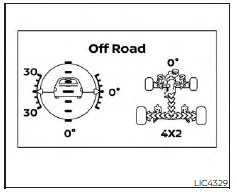
OFF-ROAD AND 4–WHEEL DRIVE (4WD) MONITOR (if so equipped)
The off-road and 4WD monitor displays the various conditions of the vehicle.
The Pitch and Roll Gauge (left) indicates the angle of the vehicle position left, right, up, or down. The value will be displayed while the vehicle graphic will rotate to indicate vehicle condition: left, right, up or down Tire Angle & 4WD Gauge (right) indicates the angle of the tires based on turning of the steering wheel and 4WD status. The graphic image will show the actual vehicle tire position while the angle is to be displayed above as a reference. The 4WD status is displayed below..
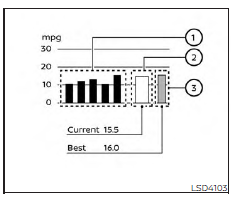
ECO-DRIVE REPORT (if so equipped)
When the ignition switch is in the OFF position, the ECO management display appears.
- Previous 5 times (History)
- Current fuel economy
- Best fuel economy
The result of ECO evaluation is displayed 30 seconds after the ignition switch is placed in the ON position and the vehicle is driven at least 1/3 miles (500 meters).
- The average fuel economy for the previous 5 times will be displayed.
- The average fuel economy since the last reset will be displayed.
- The best fuel economy of the past history will be displayed.
The ECO Drive Report can be set to be ON or OFF.
WARNING LIGHTS, INDICATOR LIGHTS AND AUDIBLE REMINDERS
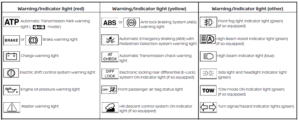

CHECKING LIGHTS
With all doors closed, apply the parking brake, fasten the seat belts, and place the ignition switch in the ON position without starting the engine.
The following Nissan Frontier dash lights (if so equipped) will come on briefly and then go off: ATP,
If any light does not come on or operate in a way other than described, it may indicate a burned-out bulb and/or a system malfunction. Have the system checked. It is recommended that you visit a NISSAN dealer for this service.
Some indicators and warnings are also displayed on the vehicle information display between the speedometer and tachometer. For additional information, see “Vehicle information display”.
WARNING/INDICATOR LIGHTS (red)
For additional information, see “Vehicle information display
Automatic Transmission Park warning light ( model)
WARNING
- If the ATP light is on, this indicates that the automatic transmission P (Park) position will not function and the transfer case is in N (Neutral).
- When parking, always make sure that the 4WD shift indicator light illuminates and the parking brake is set. Failure to engage the transfer position in 2WD, 4H or 4LO could result in the vehicle moving unexpectedly, resulting in serious personal injury or property damage.
- Shift the 4WD switch into the 2WD, 4H or 4LO position again to turn off the ATP warning light when the shift lever is in the P (Park) position and the ATP warning light is on. (Before shifting the 4WD switch into the 4LO position, move the shift lever into the N (Neutral) position once, shift the shift lever into P (Park) again and make sure the ATP warning light is off.)
If the 4WD mode indicator is off or the ATP warning light is on, this indicates that the automatic transmission P (Park) position will not function and could result in the vehicle moving unexpectedly, causing serious personal injury or property damage. Always set the parking brake. For additional information, see “Using 4–Wheel Drive (4WD).
This light indicates that the automatic transmission parking function is not engaged. If the transfer control is not secured in any drive position while the shift lever is in the P (Park) position, the transmission will disengage and the drive wheels will not lock.
BRAKE OR BRAKE Warning light
This light functions for both the parking brake and the foot brake systems.
Parking brake indicator
When the ignition switch is placed in the ON position, the light comes on when the parking brake is applied.
Low brake fluid warning light
When the ignition switch is placed in the ON position, the light warns of a low brake fluid level. If the light comes on while the engine is running with the parking brake not applied, stop the vehicle and perform the following:
- Check the brake fluid level. Add brake fluid as necessary. For additional information, see “Brake fluid”
- If the brake fluid level is correct, have the warning system checked. It is recommended that you visit a NISSAN dealer for this service.
WARNING
- Your brake system may not be working properly if the warning light is on. Driving could be dangerous. If you judge it to be safe, drive carefully to the nearest service station for re-pairs. Otherwise, have your vehicle towed because driving it could be dangerous.
- Pressing the brake pedal with the engine stopped and/or a low brake fluid level may increase your stop-ping distance and braking will re-quire greater pedal effort as well as pedal travel.
- If the brake fluid level is below the MINIMUM or MIN mark on the brake fluid reservoir, do not drive until the brake system has been checked. It is recommended that you visit a NISSAN dealer for this service.
Charge warning light
If this light comes on while the engine is running, it may indicate the charging system is not functioning properly. Turn the engine off and check the generator belt. If the belt is loose, broken, or missing or if the light remains on, have the system checked. It is recommended that you visit a NISSAN dealer for this service.
CAUTION
- Do not ground electrical accessories directly to the battery terminal. Doing so will bypass the variable volt-age control system and the vehicle battery may not charge completely. For additional information, see Variable voltage control system
- Do not continue driving if the genera-tor belt is loose, broken or missing.
Electric shift control system warning light
This light illuminates when a malfunction occurs in the electric shift control system. When the master warning light illuminates, the chime sounds and the following message is displayed in the vehicle information display: “When parked apply parking brake”.
When the ignition is placed in the OFF position, the chime sounds continuously. Ensure the parking brake is applied
Have the system checked. It is recommended that you visit a NISSAN dealer for this service.
Engine oil pressure warning light
This light warns of low engine oil pressure. If the light flickers or comes on during nor-mal driving, pull off the road in a safe area, stop the engine immediately, and call a NISSAN dealer or other authorized repair shop.
The engine oil pressure warning light is not designed to indicate a low oil level. Use the dipstick to check the oil level.
CAUTION
Running the engine with the engine oil pressure warning light on could cause serious damage to the engine almost immediately. Such damage is not covered by the NISSAN New Vehicle Limited Warranty. Turn off the engine as soon as it is safe to do so.
Master warning light
This light comes on when various vehicle information display warnings appear.
- Parking brake release warning
- Transmission system warning
Seat belt warning light and chime
- The light and chime remind you to fasten the seat belts.
- The seat belt warning light will illuminate when the ignition switch is pushed to the ON position if the driver’s seat belt is not fastened, or if the front passenger seat belt is not fastened when occupied.
- The seat belt warning light will also illuminate if a rear passenger seat belt is changed from fastened to unfastened.
- If the driver’s seat belt is not fastened when the ignition switch is pushed to the ON position, the chime will sound shortly.
- If the vehicle is driven above 9 mph (15 km/h) in the conditions that illuminate the seat belt warning light, the lamp will begin to blink and the chime will sound for over one minute, or until the seat belt is fastened again.
NOTE:
- The warning light and/or chime may activate if an object is placed in the unoccupied front passenger seat. In this case, please remove the object from the front passenger seat.
- The warning light and/or chime may activate if any seat belt is unfastened before the vehicle comes to a complete stop. Please remain fastened until the vehicle has come to a complete stop.
Security indicator light
This light blinks when the ignition switch is in the OFF, LOCK or ACC position. This function indicates the security systems equipped on the vehicle are operational.
Supplemental air bag warning light
When the ignition switch is in the ON position, the supplemental air bag warning light illuminates for about 7 seconds and then turns off. This means the system is operational.
If any of the following conditions occur, the front air bag, side air bag, curtain air bag, and pretensioner systems need servicing:
- The supplemental air bag warning light re-mains on after approximately 7 seconds.
- The supplemental air bag warning light flashes intermittently.
- The supplemental air bag warning light does not come on at all.
It is recommended that you visit a NISSAN dealer for these services.
Unless checked and repaired, the supple-mental restraint system (air bag system) and/or the pretensioners may not function properly. For additional information, see “Supplemental Restraint System (SRS)”.
WARNING
If the supplemental air bag warning light is on, it could mean that the front air bag, side air bag, curtain air bag systems, and/or pretensioner systems will not operate in an accident. To help avoid injury to yourself or others, have your vehicle checked as soon as possible. It is recommended that you visit a NISSAN dealer for this service.
WARNING/INDICATOR LIGHTS (yellow)
Anti-lock Braking System (ABS) warning light
When the ignition switch is placed in the ON position, the ABS warning light illuminates and then turns off. This indicates the ABS is operational.
If the ABS warning light illuminates while the engine is running or while driving, it may indicate the ABS is not functioning properly. Have the system checked. It is recommended that you visit a NISSAN dealer for this service.
If an ABS malfunction occurs, the anti-lock function is turned off. The brake system then operates normally but without anti-lock assistance. For additional information, see “Brake system.
Automatic Emergency Braking (AEB) with Pedestrian Detection system warning light
This light comes on when the ignition switch is placed in the ON position. It turns off after the engine is started.
This light illuminates when the AEB with Pedestrian Detection system is set to OFF in the vehicle information display.
If the light illuminates when the AEB with Pedestrian Detection system is on, it may indicate that the system is unavailable. For additional information, see “Automatic Emergency Braking (AEB) with Pedestrian Detection”.
Automatic Transmission check warning light
When the ignition switch is placed in the ON position, the light comes on for about 2 seconds. If the light comes on at any other time, it may indicate the automatic transmission system is not functioning properly. Have the system checked. It is recommended that you visit a NISSAN dealer for this service.
Electronic locking rear differential (E-Lock) system ON indicator light (if so equipped)
This light comes on when the electronic locking rear differential (E-Lock) system clutch is fully engaged.
The indicator light flashes when the system is first turned on. When the system fully engages, the light remains on. If the switch is on and the indicator light continues to flash, the system is not engaged.
Front passenger air bag status light
The front passenger air bag status light will be lit and the passenger front air bag will be off depending on how the front passenger seat is being used.
Hill descent control system ON indicator light (if so equipment.
When the ignition switch is placed in the ON position, this light comes on briefly and then turns off.
The light comes on when the hill descent control system is activated.
If the hill descent control switch is on and the indicator light blinks, the system is not engaged.
If the indicator light does not come on when the hill descent switch is on, the system may not be functioning properly. Have the system checked. It is recommended that you visit a NISSAN dealer for this service.
Low tire pressure warning light
Your vehicle is equipped with a Tire Pres-sure Monitoring System (TPMS) that monitors the tire pressure of all tires except the sharped)
The low tire pressure warning light warns of low tire pressure or indicates that the TPMS is not functioning properly.
After the ignition switch is placed in the ON position, this light illuminates for about 1 second and turns off.
Low tire pressure warning
If the vehicle is being driven with low tire pressure, the warning light will illuminate. A “Tire Pressure Low – Add Air” warning also appears in the vehicle information display.
When the low tire pressure warning light illuminates, you should stop and adjust the tire pressure of all four tires to the recommended COLD tire pressure shown on the Tire and Loading Information la-bel located in the driver’s door opening. The low tire pressure warning light does not automatically turn off when the tire pressure is adjusted. After the tire is in-flated to the recommended pressure, the vehicle must be driven at speeds above 16 mph (25 km/h) to activate the TPMS and turn off the low tire pressure warning light. Use a tire pressure gauge to check the tire pressure.
The “Tire Pressure Low – Add Air” warning appears each time the ignition switch is placed in the ON position as long as the low tire pressure warning light remains illuminated.
TPMS malfunction
If the TPMS is not functioning properly, the low tire pressure warning light will flash for approximately 1 minute when the ignition switch is placed in the ON position. The light will remain on after 1 minute. Have the system checked. It is recommended that you visit a NISSAN dealer for this service. The “Tire Pressure Low — Add Air” warning does not appear if the low tire pressure warning light illuminates to indicate a TPMS malfunction.
WARNING
- Radio waves could adversely affect electric medical equipment. Those who use a pacemaker should contact the electric medical equipment manufacturer for the possible influences before use.
- If the light does not illuminate with the ignition switch placed in the ON position, have the vehicle checked as soon as possible. It is recommended that you visit a NISSAN dealer for this service.
- If the light illuminates while driving, avoid sudden steering maneuvers or abrupt braking, reduce vehicle speed, pull off the road to a safe location and stop the vehicle as soon as possible. Driving with under-inflated tires may permanently damage the tires and increase the likelihood of tire failure. Serious vehicle damage could occur and may lead to an accident and could result in serious personal injury or death. Check the tire pressure for all four tires. Adjust the tire pressure to the recommended COLD tire pressure show on the Tire and Loading Information label located in the driver’s door opening to turn2the low tire pressure warning light off. If the light still illuminates while driving after adjusting the tire pressure, a tire may be flat or the TPMS may be malfunctioning. If you have a flat tire, replace it with a spare tire as soon as possible. If no tire is flat and all tires are properly inflated, have the vehicle checked. It is recommended that you visit a NISSAN dealer for this service.
- When using a wheel without the TPMS such as the spare tire, the TPMS will not function and the low tire pressure warning light will flash for approximately 1 minute. The light will remain on after 1 minute. Have your tires replaced and/or TPMS system reset as soon as possible. It is recommended that you visit a NISSAN dealer for these services.
- Replacing tires with those not originally specified by NISSAN could affect the proper operation of the TPMS.
CAUTION
- The TPMS is not a substitute for the regular tire pressure check. Be sure to check the tire pressure regularly.
- If the vehicle is being driven at speeds of less than 16 mph (25 km/h), the TPMS may not operate correctly.
- Be sure to install the specified size of tires to the four wheels correctly.
Malfunction Indicator Light (MIL)
If this indicator light comes on steady or blinks while the engine is running, it may indicate a potential emission control malfunction.
If this indicator light comes on steady for 20 seconds and then blinks for 10 seconds when the engine is not running, it indicates that the vehicle is not ready for an emission control system inspection/maintenance test.
Operation
The MIL will come on in one of two ways:
- MIL on steady — An emission control system malfunction has been detected. Check the fuel-filler cap if the Loose Fuel Cap warning appears in the vehicle information display. If the fuel-filler cap is loose or missing, tighten or install the cap and continue to drive the vehicle. The light should turn off after a few driving trips. If the light does not turn off after a few driving
- MIL blinking — An engine misfire has been detected which may damage the emission control system. To reduce or avoid emission control system damage:
- do not drive at speeds above 45 mph (72 km/h).
- avoid hard acceleration or deceleration.
- avoid steep uphill grades.
- if possible, reduce the amount of cargo being hauled or towed.
The MIL may stop blinking and come on steady. Have the vehicle inspected. It is recommended that you visit a NISSAN dealer for this service. You do not need to have your vehicle towed to the dealer.
CAUTION
Continued vehicle operation without having the emission control system checked and repaired as necessary could lead to poor drivability, reduced fuel economy, and possible damage to the emission control system.
Master warning light
This light comes on when various vehicle information display warnings appear.
- No key warning
- Low fuel warning
- Low windshield-washer fluid warning
- Loose fuel cap warning
- Low tire pressure warning
- 4WD error (if so equipped)
- Front & rear tire size differences (if so equipped)
Rear Automatic Braking
(RAB) system warning light (if so equipped)
This light comes on when the ignition switch is placed in the ON position. It turns off after the engine is started.
This light illuminates when the RAB system is turned off in the vehicle information display.
If the light illuminates when the RAB system is on, it may indicate that the system is unavailable. For additional information, see “Rear Automatic Braking (RAB)”.
Slip indicator light
This indicator light will blink when the Vehicle Dynamic Control (VDC) system is operating, thus alerting the driver to the fact that the road surface is slippery and the vehicle is nearing its traction limits.
You may feel or hear the system working; this is normal.
The light will blink for a few seconds after the VDC system stops limiting wheel spin.
The indicator light also comes on when you place the ignition switch in the ON position. The light will turn off after approximately 2 seconds if the system is operational. If the light does not come on have the system checked. It is recommended that you visit a NISSAN dealer for this service.
Vehicle Dynamic Control (VDC) OFF indicator light
This indicator light comes on when the VDC OFF switch is pushed to off. This indicates the VDC system is not operating.
Push the VDC OFF switch again or restart the engine and the system will operate normally. For additional information, see “Vehicle Dynamic Control (VDC) system”.
The VDC OFF indicator light also comes on when you place the ignition switch in the ON position. The light will turn off after about 2 seconds if the system is operational. If the light stays on or comes on along with the indicator light while you are driving, have the VDC system checked. It is recommended that you visit a NISSAN dealer for this service.
While the VDC system is operating, you might feel a slight vibration or hear the system working when starting the vehicle or accelerating, but this is normal.
Front fog light indicator light (green) (if so equipped)
The front fog light indicator light illuminates when the front fog lights are on.
High Beam Assist indicator light (green) (if so equipped)
This indicator light illuminates when the headlights come on while the headlight switch is in the AUTO position with the high beams selected. This indicates that the high beam assist is operational.
High beam indicator light (blue)
This blue light comes on when the head-light high beams are on and goes out when the low beams are selected.
The high beam indicator light also comes on when the passing signal is activated.
Side light and headlight indicator light (green)
The side light and headlight indicator light illuminates when the side light or headlight position is selected.
TOW mode ON indicator light (green) (if so equipped)
This light comes on when the tow mode function is on.
Turn signal/hazard indicator nissan frontier dash lights (green)
The appropriate light flashes when the turn signal switch is activated.
Both lights flash when the hazard switch is turned on.
AUDIBLE REMINDERS
Brake pad wear warning
The disc brake pads have audible wear warnings. When a disc brake pad requires replacement, it makes a high-pitched scraping sound when the vehicle is in motion, whether or not the brake pedal is depressed. Have the brakes checked as soon as possible if the warning sound is heard.
Light reminder chime
With the ignition switch placed in the OFF position, a chime sounds when the driver’s door is opened if the headlights or parking lights are on.
Turn the headlight control switch off before leaving the vehicle.
NISSAN Intelligent Key® door buzzer
The Intelligent Key door buzzer sounds if any one of the following improper operations is found.
- The Intelligent Key is left inside the vehicle when locking the doors.
- The Intelligent Key is taken outside the vehicle when operating the vehicle.
When the buzzer sounds, be sure to check both the vehicle and the Intelligent Key.
FAQs
The check engine light is a critical warning indicator that could signal various issues ranging from a loose gas cap to a more serious engine malfunction. It’s advisable to have your vehicle diagnosed by a professional to determine the exact cause.
Your owner’s manual will have a complete guide to all dashboard lights, including warning and indicator lights. It’s important to familiarize yourself with these symbols so you can respond appropriately if they illuminate.
If the brake system warning light stays on, it may indicate an issue with the braking system. Ensure the parking brake is fully released, and if the light remains on, it’s crucial to stop driving and have your vehicle inspected immediately for safety.
You should check your tire pressure as soon as possible. Driving on underinflated tires can cause poor handling, increased wear, and can lead to tire failure.
This light signifies a charging system issue that could involve the battery, alternator, or other electrical components. It’s important to address this immediately to avoid being stranded with a dead battery.
Stop driving as soon as it’s safe to do so, and check the oil level. If the level is low, add oil as needed. If the light stays on even with sufficient oil, it could indicate an oil pump issue or a leak, and you should have a mechanic inspect the vehicle.
This indicates that the engine temperature is too high, which can lead to overheating. Pull over safely, stop the engine to let it cool, and check the coolant levels once the engine has cooled down. Overheating can cause significant engine damage, so have the vehicle checked by a professional if this occurs.
The master warning light can be triggered by various issues or system errors. It’s often accompanied by a message in the vehicle information display. Check the display and refer to your owner’s manual for specific information.
Green and blue indicator lights are typically informational and indicate that a system is active or in use, like the turn signals (green) or high-beam headlights (blue).
Yes, some lights, such as the service engine soon or maintenance required light, can indicate that the vehicle is due for routine maintenance. Check your service schedule to confirm if maintenance is needed.
Useful Links
View Full User Guide: Nissan FRONTIER 2023 User Guide
Download Manuals: https://www.nissanusa.com/owners/ownership/manuals-guides.html
2023 Nissan Frontier Specs, Price, Features and Mileage


